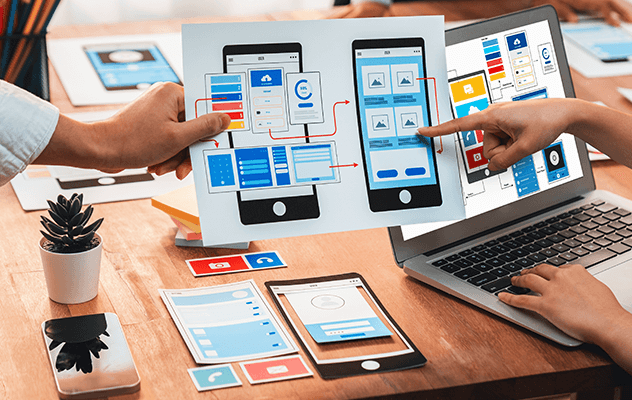
We’ve all heard the news: AI is taking the world by storm.
As a designer, one would think it to be a grave threat to our profession, as artificial intelligence (AI) is also very much capable of executing creative work.
In a lot of ways, AI carries out creative tasks up to some extent that humans have also been doing, if not beyond that.
So it’s not hard to notice the potential that AI has to replace human-dependent jobs.
In the field of UX Design, however, AI is not likely to take over fully.
In fact, from what I’ve learned and observed while using AI tools in my design process, I’ve realized that AI can act as a co-pilot that can enhance our products while working.
If you look at the AI tools for designers out there, in particular those that are both image and text generation tools, designers have found that they’re not always very accurate and often require human judgment.
With that being said, there’s no reason not to make use of AI tools; they can do wonders in terms of acting as an aid to super-charge your design process.
In this article, I share my findings from my first-hand investigation into AI tools for designers and implementing them to boost different stages of the design process.
Requirement Analysis
Project requirements are integral to the design process, and this is one big area where using digital tools like Notion can be very beneficial.
On its own, Notion is a great tool for documentation and project management.
But we’ve only gotten to really see its super-charged potential ever since the integration of AI.
With AI, Notion has turned into a powerhouse, enabling you to carry out a plethora of tasks with your document, like:
- Summarizing a requirement document
- Generating user stories
- Finding action items
- Improving your writing (you can even change the language or the overall tone of your writing)
Once you have all of these documented and generated, you can put them in a separate file so you can look at it at another time in the future.
User Research
We’re all familiar with OpenAI’s ChatGPT.
This AI model can be used for various aspects of user research for design, including:
- User Personas
- Empathy Maps
- Competitive Analysis
- Storyboarding
- Information Architecture
Let’s take an example that I worked on:
By providing the right prompts, I was able to generate a user persona for someone who frequently uses food delivery apps.
ChatGPT provided detailed information about the persona’s demographics, goals, pain points, and behaviors.
It also helped with empathy mapping, competitive analysis, and even created a basic layout for the information architecture of the food delivery application.
To delve deeper into the user’s pain points, I asked AI to elaborate on the pain points of users who use food delivery applications. The information provided was insightful and could be stored for future reference.
Next, I also wanted to also do some competitive analysis.
So, I asked the AI model, and the results it popped were able to explain to me how popular food delivery products work, with examples like UberEats, DoorDash, GrubHub, Postmates, and Seamless.
In case of storyboarding, while ChatGPT cannot give you image results, it gives you information in frames, and different frames have different illustrations of what the user does while interacting with an application.
Through text, ChatGPT gives you a rough direction of what each frame in a storyboard would look like.
One con, however, of this model is that it lacks contextual knowledge.
So even if you generate such information, you have to take a close look at it and modify it according to your project.
Wireframes
Wireframe designer is a plugin that is integrated in Figma and allows you to generate wireframes based on prompts.
As an example, I asked it to generate the wireframe for the homepage of a food delivery application, and while the result was a bit unconventional (we don’t see many homepages in food delivery applications where there’s a banner on top and different categories of the items available in the menu), it stood out as different.
What this example shows us is that this is definitely a step in the future, and wireframes and design generation from text can be way more accurate.
Speaking of which, another tool called User ID lets you create wireframes from your paper scripts and sketches directly, and makes them editable (although, they cannot be imported in Figma.
High Fidelity Design
As we move into high fidelity design, there is another tool called Auto Designer that also lets you create high quality screens from prompts — and they’re highly editable.
Just like Figma, this tool is also very collaborative.
If you look at the basics of high fidelity design (the layout, spacing, and the structure of your pages), those are all things you have to manage yourself and can’t rely on AI to handle. This is where the creativity gap lies between humans and AI: AI lacks the creative input that is so vital to the design process.
Another AI tool that is particularly helpful with the coloring part of the process. is Chroma.
Chroma is an AI tool that generates color palettes, and their combination with text.
On the platform, you can select colors of your choice and the AI tool will train its model over the colors you select.
Finally, the tool gives you the results in the form of color palettes and color swatches with text as well.
This is a very interactive tool that lets you swap through colors, get a lot of inspiration, and add them as favorites to add in your high fidelity design. ,
Testing
Once the high-fidelity design is ready, tools like the Attention Insight plugin in Figma can provide valuable insights.
The plugin creates a heat map and a focus map for the screen, showing where users are likely to focus more.
This offers valuable insight and information that can be used to make necessary amendments in your design as needed.
Takeaway
AI tools for designers, although not flawless, can substantially improve your design process.
They can serve as an initial point, offer inspiration, and even carry out tasks that save designers valuable time.
What AI is definitely not is a substitute for human discernment and creativity.
Designers must still scrutinize and fine-tune the results from these tools to ensure they align with the project’s needs and standards.
Ultimately, AI tools for designers are just that – tools. They are here to assist us, not supplant us, in our creative endeavors.



